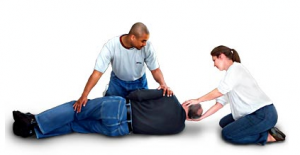Putting it into practice
24 August 2008 - 8:31pm — PeterO
You are riding on a sunday morning when you round the corner and come across a bike in the ditch and a dazed rider lying on the verge of the road.
You've checked that:
'''H''' you and your patient are safe ie no Hazards
'''H''' your patient is talking coherently but in pain
'''H''' you've asked someone to call 082911 for help and report back to you
'''A''' Airway is ok ... he's talking to you so '''B'''reathing and '''C'''irculation are ok too.
CPR is therefore not necessary (people who are awake get very irritable if you try to do CPR on them!) Remember CPR is a last resort for someone who is dying.
What now?
'''LIFE OVER LIMB'''
Are there any other life threatening injuries? If so, treat them - bleeding from an artery will cause death within minutes so stop the bleeding using pressure. Pack bandaging (rip up a t-shirt) over the wound and wrap tightly to stop the bleeding. Don't remove an soaked bandage ... just add more.
Tourniquets are not a good idea except in extreme situations because they totally block off circulation, leading to the eventual need for amputation of the limb. Pressure bandages are preferable.
'''SPINAL MANAGEMENT'''
After ascertaining that the patient is in a bad way but in no danger of dying immediately, stabilise him/her.
1. Don't remove the helmet - leave that for the paramedics.
2. Hold the head in the position that is in. Try your best not to move it. The paramedics will strap the head using head blocks and a neck brace, when they arrive. Until then, hold the head and don't move away until they take over and tell you to. Keep talking to the patient - he/she will be in shock and need continual reassurance.
3. Keep monitoring vital signs. If the patient starts slipping into unconsciousness, remember life over limb. If the need for CPR arises that is more important than the spine. Maintain as good an airway position as is possible without moving the head - obviously if the head position is blocking the airway it will have to be moved as carefully as possible and then stabilised.
The picture below shows the procedure for moving the patient onto a stretcher/backboard. I have found it to be more comfortable and easier to maintain a stable position by lying flat on the ground with my hands holding the shoulders and holding the head with the inside of my forearms. This is personal preference and will depend on your physical build.
 Stabilising the spine: The female responder might want to lie down for better comfort and stability
Stabilising the spine: The female responder might want to lie down for better comfort and stability
 Log Roll : Rolling the patient to place a backboard under them: There should be more helpers to roll the patient. Rolling is done on the command "One Two THREE" by the person holding the head
''The world needs dreamers that DO!''
Log Roll : Rolling the patient to place a backboard under them: There should be more helpers to roll the patient. Rolling is done on the command "One Two THREE" by the person holding the head
''The world needs dreamers that DO!''
 Stabilising the spine: The female responder might want to lie down for better comfort and stability
Stabilising the spine: The female responder might want to lie down for better comfort and stability
 Log Roll : Rolling the patient to place a backboard under them: There should be more helpers to roll the patient. Rolling is done on the command "One Two THREE" by the person holding the head
''The world needs dreamers that DO!''
Log Roll : Rolling the patient to place a backboard under them: There should be more helpers to roll the patient. Rolling is done on the command "One Two THREE" by the person holding the head
''The world needs dreamers that DO!''
- Printer-friendly version
- 6305 reads

